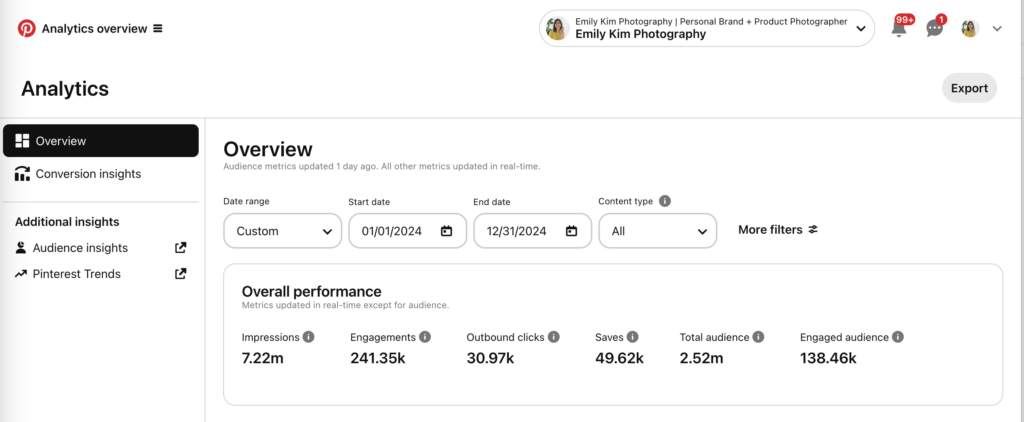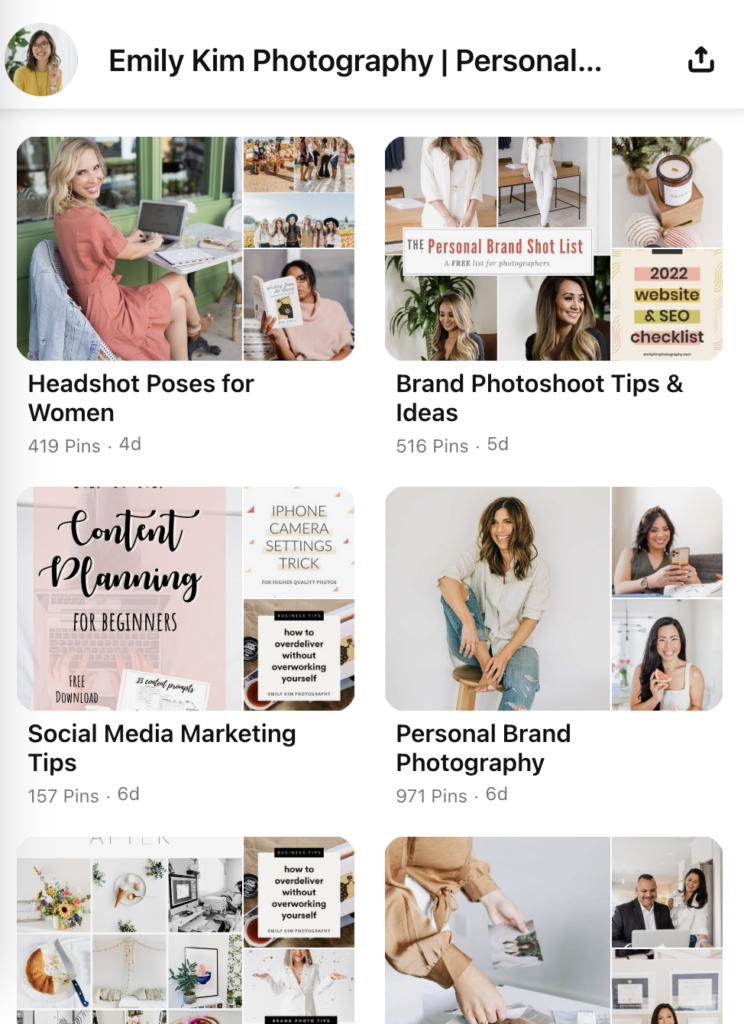If you’re a brand photographer and not taking advantage of Pinterest, it’s time to start! Pinterest is one of the most powerful visual search engines available, and it’s often the very first stop for anyone seeking creative inspiration. Imagine your client planning their brand photo shoot and saving your images to their Pinterest mood board—before they’ve even realized that you’re the one behind the photos! That’s the magic of Pinterest marketing for brand photographers.
Many photographers focus solely on pinning and optimizing their pins but overlook what happens once that traffic arrives on their site. In this post, I’ll walk you through the second part of a successful Pinterest strategy: keeping people on your website after they click through from Pinterest. Here’s how you can leverage Pinterest to boost your website’s traffic and keep your potential clients around long enough to connect with you.
Prefer to watch a video?
Why Pinterest Matters for Brand Photographers
Pinterest isn’t just another social media platform; it’s a visual search engine. People flock there to find photo shoot inspiration, mood boards, prop ideas, wardrobe styling, location ideas, and more. This is why Pinterest marketing for brand photographers makes so much sense: it puts your portfolio front and center for dream clients actively searching for your style of photography.
I’ve personally used Pinterest for years to promote my brand photography services, and it has brought me thousands of website visitors—and plenty of new clients. In one recent year, my Pinterest pins garnered:
- 7.2 million impressions (the number of times pins showed up on someone’s screen)
- 241,000 engagements (clicks and saves)
- 30,000+ outbound clicks (people visiting my website)
That’s over 30,000 potential new clients or leads who might never have found my work if it weren’t for Pinterest.

The Two-Part Pinterest Strategy
When you think about Pinterest marketing, you might focus on the typical questions:
- “What do I pin?”
- “How do I write pin titles and descriptions?”
These are crucial steps, and there are many resources (including my Pinterest manager Kathryn’s Pinterest Masterclass) to help you optimize pin creation. However, there’s a second part that gets overlooked:
How do you keep people on your website once they click over from Pinterest?
Generating traffic is only the first step; the next big goal is to retain that traffic long enough to build real connections, offer value, and convert visitors into paying clients.
Step 1: Pin Your Client Blogs to Location-Specific (and Other Relevant) Boards
A powerful tactic is to create location-specific blog posts and then pin them to relevant Pinterest boards. For instance, if you’re a brand photographer in Boston, you might write blog posts about:
- “Brand Photography Locations in Boston”
- “How to Prep for a Downtown Boston Brand Shoot”
- “Best Co-Working Spaces for Photo Shoots in Cambridge”
(If you’re new to creating location-specific blog posts, check out my previous content on that!)
Once you’ve published these blog posts, you’ll pin their images to your Pinterest boards. Some of the boards I keep include:
- Personal Brand Photography
- Styling & Flat Lay Inspiration
- Headshot Poses for Women
- Headshot Poses for Men
Each pin links directly back to a relevant blog post. The key is to ensure your boards’ names match terms people actively search for on Pinterest. This helps the Pinterest algorithm categorize your pins and recommend them to more users.

Step 2: Create Boards People Are Actually Searching For
Pinterest boards function much like categories or topics. They signal to Pinterest (and your audience) what your pins are about. Examples of potential boards for brand photographers include:
- Lifestyle Brand Photography Ideas
- Location Scouting Tips
- Photography Wardrobe Inspiration
- Color Palette Inspiration for Brand Shoots
The boards should speak to your clients’ needs. If people are searching for “headshot poses” or “flat lay inspiration,” be sure your board names reflect these keywords. That way, when someone’s planning their brand session or mood board, your pins are more likely to appear in their feed.
Step 3: Keep Visitors on Your Website
Once a Pinterest user clicks through to your site, the real work begins. You need to keep them engaged. That might sound easy, but remember: people on Pinterest are often in a browsing mindset. They might open multiple tabs, skim quickly, and exit just as fast.
1. Add Internal Links
To reduce bounce rate and keep visitors on your site, link to other relevant blog posts or pages within your content.
For example, at the end of each of my blog posts, I include a “You Might Also Enjoy…” section that highlights other blog posts that are related to the one they are currently viewing. Scroll to the bottom to see what I mean!
This way, if someone loves my content, they can dive deeper into my site rather than heading back to Pinterest.

2. Offer a Freebie or Lead Magnet
Pinterest users often hop from pin to pin, so they may forget where they found a great post. To combat this, include a call to action (CTA) encouraging visitors to sign up for your email list. Offering an enticing lead magnet—like a PDF guide on “How to Prepare for a Brand Photoshoot” or “5 Essential Props for Stunning Headshots”—is a great way to capture their email address.
Once they’re on your email list, you can continue to nurture that relationship through follow-up sequences, tips, behind-the-scenes stories, or even special offers.

Step 4: Understanding the SEO Connection
You may be wondering, “Does Pinterest directly boost SEO?” It’s more of an indirect effect. By pinning your blog posts:
- You drive more visitors to your site from Pinterest.
- If they stay longer—clicking around or exploring multiple pages—search engines could interpret that as a positive user signal.
- Better user signals can potentially help search engines view your site as valuable and relevant, which may improve your SEO over time.
*A quick caveat: simply keeping someone on your site isn’t a direct ranking factor for search engines, but improved user engagement is often correlated with better search visibility. At the end of the day, it’s all about providing high-quality, interesting content.
Bonus Tip: Partner with a Pinterest Expert
Yes, you can manage your own Pinterest account. I did it myself for years. But if you really want to accelerate your results, consider handing over the reins to an expert. My personal go-to is Kathryn from The Sustainable Strategy Company. Her free Pinterest Masterclass is phenomenal if you’d rather DIY with expert guidance, and she’s also a top-notch Pinterest manager and the only person I trust with my account.

Quick Recap and Action Steps
- Set up boards that reflect topics your ideal clients are actively searching for.
- Pin your blog posts and client galleries to these boards.
- Keep people on your website longer with internal links to relevant posts that they might also be interested in.
- Capture email addresses with a freebie or lead magnet.
- Consider hiring a Pinterest expert if you want to level up quickly.
By following these steps, you’ll be well on your way to leveraging Pinterest marketing for brand photographers—driving more visitors to your site, showcasing your portfolio to a wider audience, and ultimately converting casual browsers into passionate clients.
Ready to Take Your Pinterest Strategy Further?
- If you’re brand new to Pinterest or want to refine your approach, check out Kathryn’s Pinterest Masterclass.
- Interested in learning how to grow your email list as a photographer? Let me know in the comments—I might just make that my next YouTube video or blog post!
Now get pinning—your dream clients are waiting to be inspired by your work!
Be the first to comment